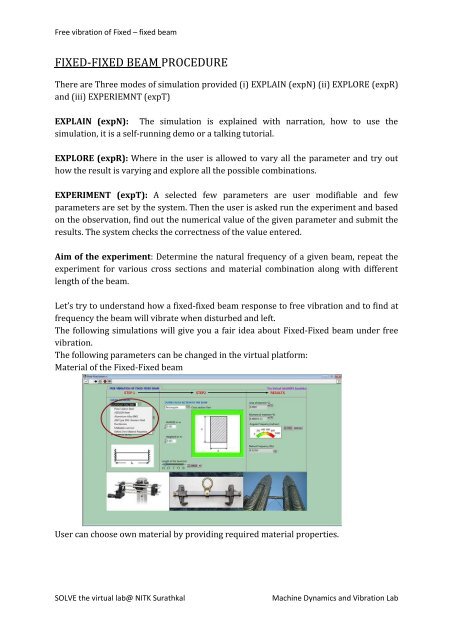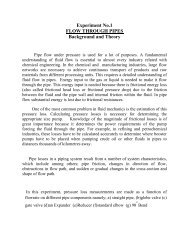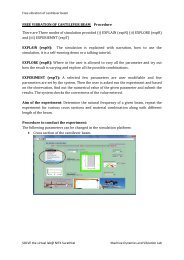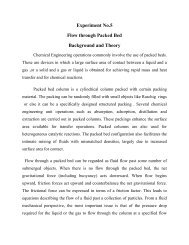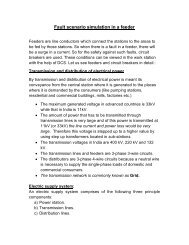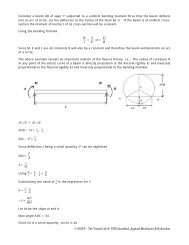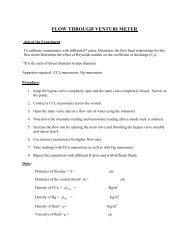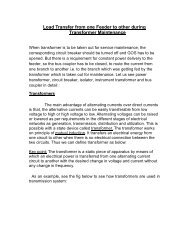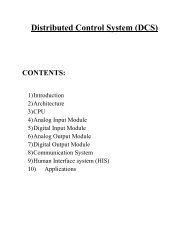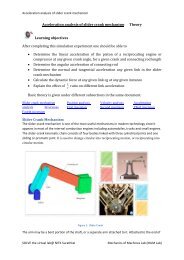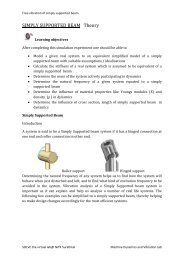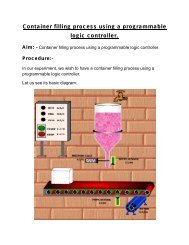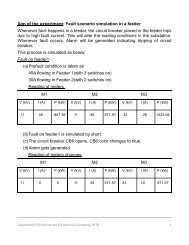fixed-fixed beam procedure - SOLVE - The Virtual Lab @ NITK ...
fixed-fixed beam procedure - SOLVE - The Virtual Lab @ NITK ...
fixed-fixed beam procedure - SOLVE - The Virtual Lab @ NITK ...
- No tags were found...
Create successful ePaper yourself
Turn your PDF publications into a flip-book with our unique Google optimized e-Paper software.
Free vibration of Fixed – <strong>fixed</strong> <strong>beam</strong>FIXED-FIXED BEAM PROCEDURE<strong>The</strong>re are Three modes of simulation provided (i) EXPLAIN (expN) (ii) EXPLORE (expR)and (iii) EXPERIEMNT (expT)EXPLAIN (expN): <strong>The</strong> simulation is explained with narration, how to use thesimulation, it is a self-running demo or a talking tutorial.EXPLORE (expR): Where in the user is allowed to vary all the parameter and try outhow the result is varying and explore all the possible combinations.EXPERIMENT (expT): A selected few parameters are user modifiable and fewparameters are set by the system. <strong>The</strong>n the user is asked run the experiment and basedon the observation, find out the numerical value of the given parameter and submit theresults. <strong>The</strong> system checks the correctness of the value entered.Aim of the experiment: Determine the natural frequency of a given <strong>beam</strong>, repeat theexperiment for various cross sections and material combination along with differentlength of the <strong>beam</strong>.Let’s try to understand how a <strong>fixed</strong>-<strong>fixed</strong> <strong>beam</strong> response to free vibration and to find atfrequency the <strong>beam</strong> will vibrate when disturbed and left.<strong>The</strong> following simulations will give you a fair idea about Fixed-Fixed <strong>beam</strong> under freevibration.<strong>The</strong> following parameters can be changed in the virtual platform:Material of the Fixed-Fixed <strong>beam</strong>User can choose own material by providing required material properties.<strong>SOLVE</strong> the virtual lab@ <strong>NITK</strong> SurathkalMachine Dynamics and Vibration <strong>Lab</strong>
Free vibration of Fixed – <strong>fixed</strong> <strong>beam</strong>Cross section of the Fixed-Fixed <strong>beam</strong>.For chosen cross section, the system calculates the area and area moment. Effectivelength of simply supported <strong>beam</strong> can also be varied by the user.Effective length of <strong>fixed</strong>-<strong>fixed</strong> <strong>beam</strong> is also a variable which user can change.<strong>The</strong> results that we arrive at are:Natural frequency of the system.In the EXPLORE (expR) mode of simulation for any given combination of material, crosssection and <strong>beam</strong> length, system calculate the natural frequency and display to the user.In the EXPERIMENT (expT) mode, user can choose material, cross section and length ofthe <strong>beam</strong>, the system calculates mass and area moment and display, user is expected tocalculate the natural frequency and enter the calculated value and submits the answer.<strong>The</strong> correctness of the answer will be checked by the system and informed to user.<strong>SOLVE</strong> the virtual lab@ <strong>NITK</strong> SurathkalMachine Dynamics and Vibration <strong>Lab</strong>
Free vibration of Fixed – <strong>fixed</strong> <strong>beam</strong>ObservationSlNo CrosssectionSection Property(b,h, or diameter )Length Young’s modulus (E) Density ()CalculationsSlNo Area(A)Area moment (I)Mass(M )Stiffness (K)NaturalFrequency (n)Inference and Conclusions{find out how the natural frequency varies with each of the variables , and write in yourown word the collusion from the experiment}Further reading beyond this experiment:Effective mass of a continuous systemIn an experimental set up however, the simply supported <strong>beam</strong> acts as a continuousmass system. Hence an effective mass for the system needs to be calculated.By referring to http://teaching.ust.hk, we have arrived at the following soln. For theeffective mass.wherem= mass in the middle of the <strong>beam</strong> (sensing element etc.) (kg)=mass density of material of Fixed-Fixed system (mass/unlit length)(kg/m)=effective length of the Fixed-Fixed <strong>beam</strong> (m)Energy consuming element – DampingIf we introduce energy consuming element called damping then the equation getmodified tö ̇ ; ̈ ̇Wherex = displacement of the free end of the cantilever <strong>beam</strong> (m)C = Damping present in the system (Kg/s)= Damping Coefficient of the system<strong>The</strong> solution for SDOF damped free vibration governing equation<strong>The</strong> solution to the above system changes depending on the initial conditions = initialdisplacement and = initial velocity, the damping coefficient =<strong>SOLVE</strong> the virtual lab@ <strong>NITK</strong> SurathkalMachine Dynamics and Vibration <strong>Lab</strong>
Free vibration of Fixed – <strong>fixed</strong> <strong>beam</strong>Let us consider the 3 cases:CASE 1: = damping coefficient < 1 (Underdamped systems.)( ) ( ( ))( )( )Where = damped natural frequency = √( )CASE 2:= damping coefficient = 1 (Critically damped systems.)( ) ( ) (( )CASE 3:= damping coefficient > 1 (Overdamped systems.)( )(√ )[ ( ( (√ ) )(√ )](√ )(– ( (√ ) )[(√ )]<strong>SOLVE</strong> the virtual lab@ <strong>NITK</strong> SurathkalMachine Dynamics and Vibration <strong>Lab</strong>


